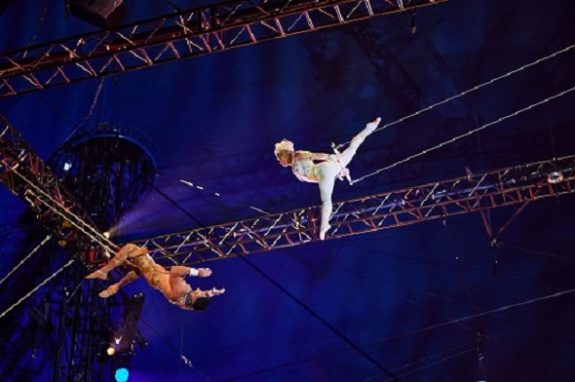 United Kingdom Cirque du Soleil – Alegría, in a new light: Royal Albert Hall, London, 17.1.2024. (CS)
United Kingdom Cirque du Soleil – Alegría, in a new light: Royal Albert Hall, London, 17.1.2024. (CS)

Production:
Creation director (2019) – Daniel Ross
Director (2019) – Jean-Guy Legault
Costume designer – Dominique Lemieux
Set and Props designer – Anne-Séguin Poirier
Lighting designer – Mikki Kunttu
Composer and Arranger – René Dupéré
Musical director and Arranger – Jean-Phi Goncalves
Acrobatic Choreographer and Acrobatic Performance designer – Émilie Therrien
Cirque du Soleil have returned to the Royal Albert Hall with an old favourite, Alegría, presenting the show which has been staged more than 6,000 times and enjoyed by millions since it was first seen in 1994, ‘in a new light’ (‘un nouveau jour’, 2019).
Cirque shows have varying degrees of narrative direction and coherence. Totem (2010) is ambitious in tracing the evolution of human life from amphibian to air-borne, and in its exploration of man’s relationship with the natural world. Corteo (2005) presents a more traditional blend of folk and fairy tale, mixing the mundane and the surreal. Luzia (2016) tells its dazzling tale through technical wizardry and high-octane innovation. The narrative of Alegría is perhaps less pretentious than some and has a more homely charm – though that doesn’t necessarily make it any more coherent!
Anne-Séguin Poirier’s set presents a soaring, spiky arch – reminiscent of a primordial forest – at the centre of which perches a gilded thorny throne. It lacks an inhabitant, the King being long dead, and the King’s Fool, Mr Fleur, fancies his chances at ruling the kingdom. So, the red-garbed jester, a spry Rumpelstiltskin-like figure (Bogdan Zavalishyn), seats himself in the throne’s prickly embrace, enjoys the adulation of some butterfly-winged nymphs, and watches as a struggle for power unfolds between the old aristocrats – their extravagant costumes (Dominique Lemieux) crossing Dickensian caricature with commedia dell’arte – and a new order of bronzed ‘Bronx’ warriors.

At least, that’s what the programme book explains. Ideas such as hope, resilience and renewal infuse the songs and music which accompany the action, as René Dupéré’s powerhouse soundtrack is belted out ear-pleasingly but innocuously by two singers (Sarah Manesse and Cassia Raquel), one dressed in white, the other in black, accompanied by accordion, strings and percussion, the latter vibrant and virtuosic.
Interjected between the astonishing acrobatic feats is a long-running love-hate knockabout between two clowns, complete with ear-piercing cackles and squeals. How much one enjoys the comedic hyperbole executed by Pablo Bermejo Medina and Pablo Gomis Lopez will depend upon personal inclination and taste. I found it somewhat tedious, and tangential to the main ‘narrative’. But, it fills the gaps as the performers make the necessary preparations for the following act, and is harmless enough. And, the snowstorm which engulfs the hapless pair at the end of the first part is a manic maelstrom of whirling confetti and swirling lights which spills beyond the arena into the RAH corridors. The cleaning team must have a hell of a job to clear up the paper fragments the next morning.
As always, though, it’s the feats of strength, skill and stamina that take one’s breath away. Alegría seems to me to present fewer ensemble spectacles than other Cirque shows I’ve seen, but if the emphasis is on individual control, power, grace, balance and poise then there is no lack of mind-blowing physical virtuosity and display.
Ghislain Ramage becomes one with his Cyr wheel, executing a brilliantly controlled and poised routine which is an absolute alliance of strength and grace. Even when the wheel seems to be spinning on a near-horizontal axis, writhing to a thumping beat, Ramage is elegant within its frame, and his steely gaze remains as unwavering as the single hand that sometimes welds him to the wheel as it whips around. The trapeze duo, Roxanne Gilliand and Nicolai Kuntz, execute perfectly synchronised twists and tumbles as they dangle aloft. The elegance and audacity of aerial strap artists Yulia Makeeva and Alexey Turchenko, as their bodies interweave in mid-air, is breathtaking. How on earth does Turchenko catch Makeeva, as she slithers and spins, with his feet? How can she be suspended by his neck? One really does blink and wonder if one’s eyes have deceived one.

Daria Kalinina and Halina Starevich’s meticulous and masterful ‘hand-to-hand’ gymnastics sees the two women move as one body, their unfolding movements amphibious, beautiful, requiring astonishing balance and strength, qualities to which are added flexibility and zest by Zhuang Yan, as she spins hula hoops with her toes, while perched with perfect poise on one hand, or bursts with energy as she turns herself into a glittering spinning top.
There are, of course, some stunning ensembles, not least ‘Powertrack’ which turns the arena platform into a criss-cross trampoline across which tumblers race, athletic and exuberant, their adrenalin rising as they execute a tempest of ever-more impudent twists, flips and rolls. The sheer exhilaration etched not just on their faces as they land their flights, but also in every inch of muscle and sinew, is intoxicating. The show starts with acro poles: how can someone be bounced from a bendy pole, tossed into the air, turn, tuck and flip umpteen times and then land, as secure as an oak tree’s roots, feet-first on the shoulders of someone who is themselves balanced on someone else’s shoulders? It’s a blend of micro-precision, muscularity and sheer miracle. Then there’s Falaniko Solomona Penesa whose fearless, frenetic juggling gives the phrase ‘playing with fire’ a whole new meaning.
The show closes with a flying trapeze finale. Sitting under the ‘flight path’ of the athletes as they flung themselves with gleeful abandon from the RAH rafters, somersaulting with superhuman confidence and synchronicity, was a frankly jaw-dropping experience.
‘Alegría’ is a Mexican-Spanish word meaning happiness and gaiety. This show certainly serves up a surfeit of joy.
Alegría continues at the Royal Albert Hall until 3rd March.
Claire Seymour
